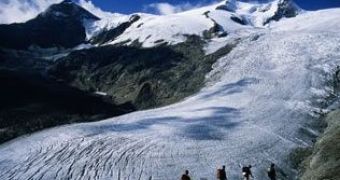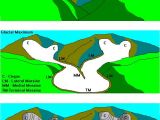We consider ice just a solid, brittle, crystalline material because we use to see it in small amounts.
But when ice forms a ticker layer, of 60-100 m (200-330 ft), the under part behaves like a plastic material, engaged in a slow flow so that the whole ice mass spreads over an extended area or displace on slope.
This behavior characterizes any land glacier, from the past or the present.
For a glacier to emerge, the snowfall from the past winter must overpass the melting or evaporation (the so-called ablation). This way, each year, a new layer of snow adds to the previous ice mass. By the melting and re-freezing of the upper layer, the snow is turned in granulated ice, which can experience hardening under the pressure of the upper layers, and is turned in crystalline compact ice.
When the ice layers gets so thick that the bottom layers turn plastic, the slow downward flow of the ice accumulated in the high mountains is triggered and an active glacier is born.
Glaciers generated on the high mountains are usually narrow and long, as they occupy pre-existent valleys. While moving towards lower altitudes, where temperatures are higher, the glaciers experience ablation and the ice is lost.
The place, usually a depression, where the initial ice of the glacier collects, is called glacial cirque (accumulation zone). The snow experiencing hardening and re-crystallization is named firn. The firn territory is smooth, presenting in transversal section a concave profile.
At the moment of complete filling of the cirque with ice, the extra ice leaves the region through the so-called glacial sill. The flowing speed increases in this sector, where appear deep crevasses, which form a glacial fall.
In the lower part of the valley, in the ablation zone, the rapidly melting ice uncovers elder ice layers from below, with many rugosities and deep crevasses. On the front of the glacier, there are piles of debris carried by the glacier, called morains.
In its lower part, the glacier has a convex transversal profile, its central part being higher than its sides.
A land glacier is in a dynamic balance, in which the intensity of the accumulation in the cirque is equaled by the ablation in its lower part. Even if its flows, the glacier maintains its length and transversal section.
Generally, the flow used to be very slow, from a few centimeters to a few meters daily. But earthquakes and especially, global warming, are now speeding greatly the alpine glaciers and in the current trend we can't speak anymore about a balance: most of the current alpine glaciers will be lost in less than a half century.
Some glaciers surpass now speeds of 65 m/day. During the Ice Age, glaciers occupied most of the mountains in Europe, Asia and America, and their former activity is betrayed by glacier lakes and valleys.

 14 DAY TRIAL //
14 DAY TRIAL // 
